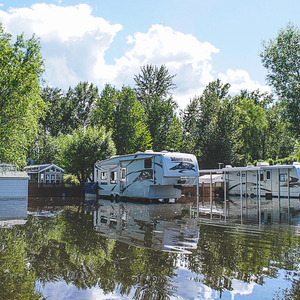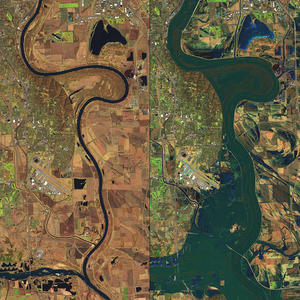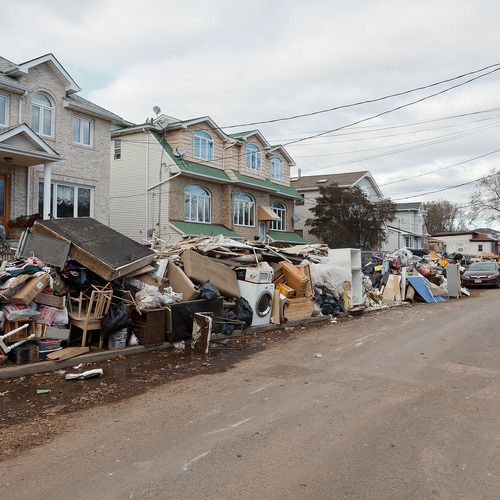
The 116th Congress, divided between a Democrat-controlled House and a Republican-controlled Senate, will more than likely continue to be driven by party rivalry, but reforming the broken National Flood Insurance Program (NFIP) could, and should, be one area where bipartisanship is possible.
Flooding disasters ignore political boundaries, impacting both red and blue communities. And for communities not directly impacted, flooding is still a financial drain since the federal government has spent billions of taxpayer dollars to help communities recover after flooding, including bailing out the NFIP.
The new Congress must not continue to dither and delay on reform; its predecessor kicked the can on reform 10 times since September 2017. The NFIP expires May 31, 2019. The 116th Congress should use the next five months to make the NFIP the cornerstone of United States’ post-flood recovery efforts, because in its current form the NFIP is a liability. As climate change continues to expose more Americans to devastating flooding, the new Congress must make NFIP reform a priority.
Major flooding disasters are occurring more frequently, and will continue to increase in frequency for the foreseeable future due to climate change and population growth, causing greater damage to people and property. To better help people mitigate, or even better, avoid flooding impacts, Congress should do the following:
Help more homeowners access voluntary buyouts
Through the NFIP, Congress should provide more assistance to help homeowners, who so desire, move out of harm’s way. Currently, the NFIP places significant emphasis on rebuilding flooded properties — often multiple times — instead of helping homeowners voluntarily relocate out of high-flood risk areas. Nationwide, the NFIP has paid to repair or rebuild more than 30,000 properties an average of five times. As the climate changes and flooding disasters occur more often, the number of families whose properties have flooded and are repeatedly rebuilt by the program is growing.
Provide greater access to flood risk and NFIP data
Prospective home buyers, as well as renters, are often kept in the dark about a property’s flood history and risk of flooding in the future.

NRDC: How States Stack Up on Flood Disclosure. The key to the color bar at the bottom reads as follows: “None [red] / Inadequate [yellow] / Adequate [light green] / Better [medium green] / Best [dark green].”
For example, in 21 states, there are no statutory or regulatory requirements that a seller disclose a property’s flood vulnerability to a buyer. The other 29 states have varying degrees of disclosure requirements, creating a hodgepodge of state and local laws. Additionally, very little information collected by the Federal Emergency Management Agency (FEMA) through the NFIP, like the number of repetitively flooded properties that are located in a community (an indicator of flood risk) is made publicly available. This information deficit distorts market signals and hinders fully informed decision-making about how to best avoid or mitigate damaging floods, putting people, property, and the NFIP at greater risk.
As part of NFIP reform, the new Congress should mandate greater disclosure and transparency of flood risk data. Such reforms should include:
- Nationwide disclosure requirements of flood risk information upon the sale or lease of a property. As a condition of participation in the NFIP, states should be required to enact disclosure laws that provide the following information about flood risk:
- Whether the home has ever been damaged by a flood and the cost of the damage;
- Whether the home is located in a 100-year or 500-year floodplain;
- Whether the seller and/or previous owners ever received federal disaster aid that would require all future owners to obtain and maintain flood insurance on the property.
- A public right-to-know provision. FEMA should be required to create a centralized, free, open-to-the-public data system to share information related to flood damage claims, number of repeatedly flooded properties, and whether communities are properly enforcing local building and zoning codes required under the NFIP.
- A homeowner right-to-know provision. Upon request, FEMA should be required to provide homeowners a “right to know” about their property’s past history of flood insurance coverage, damage claims paid, and whether there is a legal requirement to purchase flood insurance because of past owners’ receipt of federal disaster aid.
The House of Representatives earlier provided for such reforms in the “21st Century Flood Reform Act” (HR. 2874), which passed in 2017. But a new Congress will have to start with a new bill, which should also include these measures to ensure that homeowners and communities have a right to know about past floods and the potential for flooding in the future.
Improve the flood mapping program
The Federal Emergency Management Agency (FEMA) is responsible for mapping the nation’s hazardous flood areas, including coastal areas susceptible to storm surge. Federal, state, and local governments, property developers, and community planners rely on the risk information in FEMA flood maps to decide what to build, where to build, and how to build. Additionally, FEMA’s minimum floodplain building and land use requirements only apply in areas that are mapped to the 100-year flood level.
However, a 2017 investigation by the Department of Homeland Security’s Inspector General revealed that 58% of all FEMA flood maps are considered inaccurate or out-of-date. Inaccurate and out-of-date flood maps put communities at risk. Moreover, flood maps produced by FEMA fail to account for escalating flood risks in the future that are attributable to sea level rise, increasing incidents of severe weather, and other impacts of climate change. Development decisions that would appear safe today, will still face a serious risk of flooding in the future. FEMA flood maps must not only be accurate and up-to-date, but also forward-looking to better protect people and property, and ensure long-term sustainability of the NFIP. A Federal advisory committee, established to review and make recommendations to FEMA on how to improve the mapping program, specifically recommended such an approach.
Congress must ensure FEMA’s flood maps are current and are set on a glide path to include projections of future conditions to accurately depict flood risk. Fully funding the mapping program and encouraging states and NFIP communities to develop more granular flood maps, including future conditions projections, in exchange for greater grant funding should be included in any NFIP reform package.
Continue to move the program toward risk-based rates
Congress should continue to move the NFIP toward full risk-based rates to impress upon homeowners their true risk of flooding. Subsidization of policy premiums masks flood risk, distorting market signals that may normally discourage investment in flood vulnerable areas. In contrast, according to the Wharton Risk Management and Decision Process center, insurance premiums based on risk “provide individuals with accurate signals to the degree of hazard they face.”
However, a transition to full risk-based rates raises potential equity concerns. As policy premiums transition to full risk-based rates, low- to moderate-income households could be priced out, choosing either to continue to forgo coverage or drop existing coverage if the cost becomes too burdensome.
Unfortunately, simply providing affordable insurance will not stop flooding from happening. If inexpensive insurance is the only assistance a low-income household receives, they can become trapped in a cycle of flooding and rebuilding. NRDC highlighted this growing problem in the Seeking Higher Ground report. Any reforms aimed at providing affordable flood insurance must also be coupled with assistance that helps people reduce or eliminate their vulnerability to flooding in the future.
Congress should create a means-tested affordability mechanism to assist low- to moderate-income NFIP policyholders to obtain and/or maintain coverage, and also couple that assistance with greater access to mitigation assistance. Possible mitigation assistance could include:
- Provide qualifying NFIP policyholders the option of a voluntary buyout as an alternative to an insurance payout if the property is substantially damaged.
- Provide qualifying NFIP policyholders a higher amount of Increased Cost of Compliance assistance to cover the costs of elevation, relocation, or floodproofing.
- Provide qualifying NFIP policyholders access to grants or low interest loans to fund mitigation projects.
Climate change impacts will exacerbate flooding
Climate change is exposing, and will continue to expose, the vulnerability of the flood insurance program. As sea levels rise and heavy rains become more common, coastal and riverine communities can expect increasing vulnerability to flooding. Absent reform, the NFIP will only become more vulnerable. One only needs to look to the 2017 and 2018 hurricane seasons as examples of what may come and the inadequacy of the NFIP to address rising disaster costs.
Hurricanes Harvey, Irma, and Maria caused $9.8 billion in NFIP damages, and Hurricanes Florence and Michael are projected to have caused another $5 billion and $3 billion, respectively. And these are just the costs to the NFIP. The federal government will likely spend tens of billions of dollars more in disaster aid. Democrat or Republican, no one will be immune from a future of more intense and costly flooding.
The 116th Congress has the power to enact meaningful reforms to the NFIP. There are Democrats and Republicans in both houses who see the same problems and agree on the same solutions; now leadership just needs to set aside politics and actually make reforms that have bipartisan support.
Joel Scata is a water and climate attorney with the Healthy People & Thriving Communities program at the Natural Resources Defense Council. This post originally appeared at the NRDC Expert Blog.
Weekly Newsletter
Get building science and energy efficiency advice, plus special offers, in your inbox.















One Comment
“[Deleted]”
Log in or create an account to post a comment.
Sign up Log in